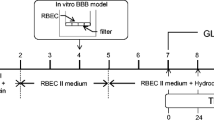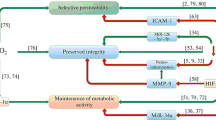Abstract
Cerebral microvascular endothelial cells—coming in contact with pericytes and astrocytes—constitute the structural basis of the blood-brain barrier (BBB). The continuous belt of interendothelial tight junctions (TJs) and the presence of specific transport systems, enzymes, and receptors in the brain endothelium regulate the molecular and cellular traffic into the central nervous system. Pituitary adenylate cyclase-activating polypeptide (PACAP) is a neuropeptide having several cellular protective effects. However, little is known about the effects of PACAP on the cerebral endothelium and BBB functions. Here, we show that PACAP has no significant pro-survival role in cerebral microvascular endothelial cells; however, it improves the barrier properties of the brain endothelium. PACAP induces an increase in the transendothelial electrical resistance, which is the most important marker of the tightness of the TJs. Moreover, PACAP has a protective role against glucose deprivation- and oxidative stress-induced junctional damage in microvascular brain endothelial cells.





Similar content being viewed by others
References
Abbott NJ, Patabendige AA, Dolman DE, Yusof SR, Begley DJ (2010) Structure and function of the blood-brain barrier. Neurobiol Dis 37:13–25
Banks WA, Kastin AJ, Komaki G, Arimura A (1993) Passage of pituitary adenylate cyclase activating polypeptide1-27 and pituitary adenylate cyclase activating polypeptide1-38 across the blood-brain barrier. J Pharmacol Exp Ther 267:690–696
Basille M, Cartier D, Vaudry D et al (2006) Localization and characterization of pituitary adenylate cyclase-activating polypeptide receptors in the human cerebellum during development. J Comp Neurol 496:468–478
Brown D, Tamas A, Reglodi D, Tizabi Y (2013) PACAP protects against salsolinol-induced toxicity in dopaminergic SH-SY5Y cells: implication for Parkinson’s disease. J Mol Neurosci 50:600–607
Castorina A, Giunta S, Mazzone V, Cardile V, D’Agata V (2010) Effects of PACAP and VIP on hyperglycemia-induced proliferation in murine microvascular endothelial cells. Peptides 31:2276–2283
Dogrukol-Ak D, Kumar VB, Ryerse JS et al (2009) Isolation of peptide transport system-6 from brain endothelial cells: therapeutic effects with antisense inhibition in Alzheimer and stroke models. J Cereb Blood Flow Metab 29:411–422
Erdling A, Sheykhzade M, Maddahi A, Bari F, Edvinsson L (2013) VIP/PACAP receptors in cerebral arteries of rat: characterization, localization and relation to intracellular calcium. Neuropeptides 47:85–92
Giunta S, Castorina A, Bucolo C, Magro G, Drago F, D’Agata V (2012) Early changes in pituitary adenylate cyclase-activating peptide, vasoactive intestinal peptide and related receptors expression in retina of streptozotocin-induced diabetic rats. Peptides 37:32–39
Grimaldi M, Cavallaro S (1999) Functional and molecular diversity of PACAP/VIP receptors in cortical neurons and type I astrocytes. Eur J Neurosci 11:2767–2772
Horai S, Nakagawa S, Tanaka K et al (2013) Cilostazol strengthens barrier integrity in brain endothelial cells. Cell Mol Neurobiol 33:291–307
Hutamekalin P, Farkas AE, Orbok A et al (2008) Effect of nicotine and polyaromtic hydrocarbons on cerebral endothelial cells. Cell Biol Int 32:198–209
Ishizaki T, Chiba H, Kojima T et al (2003) Cyclic AMP induces phosphorylation of claudin-5 immunoprecipitates and expression of claudin-5 gene in blood-brain-barrier endothelial cells via protein kinase A-dependent and -independent pathways. Exp Cell Res 290:275–288
Jaworski DM (2000) Expression of pituitary adenylate cyclase-activating polypeptide (PACAP) and the PACAP-selective receptor in cultured rat astrocytes, human brain tumors, and in response to acute intracranial injury. Cell Tissue Res 300:219–230
Kis B, Gaspar T, Mezei Z, Gecse A, Telegdy G (1999) Pituitary adenylate cyclase-activating polypeptide inhibits the cyclooxygenase pathway of rat cerebral microvessels. Acta Physiol Scand 167:43–47
Kis B, Deli MA, Kobayashi H et al (2001) Adrenomedullin regulates blood-brain barrier functions in vitro. Neuroreport 12:4139–4142
Krizbai IA, Deli MA (2003) Signalling pathways regulating the tight junction permeability in the blood-brain barrier. Cell Mol Biol (Noisy-Le-Grand) 49:23–31
Lenti L, Domoki F, Kis D et al (2007) Pituitary adenylate cyclase-activating polypeptide induces pial arteriolar vasodilation through cyclooxygenase-dependent and independent mechanisms in newborn pigs. Brain Res 1165:81–88
Miyata A, Arimura A, Dahl RR et al (1989) Isolation of a novel 38 residue-hypothalamic polypeptide which stimulates adenylate cyclase in pituitary cells. Biochem Biophys Res Commun 164:567–574
Paolinelli R, Corada M, Ferrarini L et al (2013) Wnt activation of immortalized brain endothelial cells as a tool for generating a standardized model of the blood brain barrier in vitro. PLoS One 8:e70233
Racz B, Gasz B, Borsiczky B et al (2007) Protective effects of pituitary adenylate cyclase activating polypeptide in endothelial cells against oxidative stress-induced apoptosis. Gen Comp Endocrinol 153:115–123
Reglodi D, Kiss P, Szabadfi K et al (2012) PACAP is an endogenous protective factor-insights from PACAP-deficient mice. J Mol Neurosci 48:482–492
Rubin LL, Staddon JM (1999) The cell biology of the blood-brain barrier. Annu Rev Neurosci 22:11–28
Rubin LL, Hall DE, Porter S et al (1991) A cell culture model of the blood-brain barrier. J Cell Biol 115:1725–1735
Seaborn T, Masmoudi-Kouli O, Fournier A, Vaudry H, Vaudry D (2011) Protective effects of pituitary adenylate cyclase-activating polypeptide (PACAP) against apoptosis. Curr Pharm Des 17:204–214
Stelzner TJ, Weil JV, O’Brien RF (1989) Role of cyclic adenosine monophosphate in the induction of endothelial barrier properties. J Cell Physiol 139:157–166
Sziraki I, Erdo F, Beery E et al (2011) Quinidine as an ABCB1 probe for testing drug interactions at the blood-brain barrier: an in vitro in vivo correlation study. J Biomol Screen 16:886–894
Tripathy D, Sanchez A, Yin X, Martinez J, Grammas P (2012) Age-related decrease in cerebrovascular-derived neuroprotective proteins: effect of acetaminophen. Microvasc Res 84:278–285
Tsuchikawa D, Nakamachi T, Tsuchida M et al (2012) Neuroprotective effect of endogenous pituitary adenylate cyclase-activating polypeptide on spinal cord injury. J Mol Neurosci 48:508–517
Vaudry D, Falluel-Morel A, Bourgault S et al (2009) Pituitary adenylate cyclase-activating polypeptide and its receptors: 20 years after the discovery. Pharmacol Rev 61:283–357
Weksler BB, Subileau EA, Perriere N et al (2005) Blood-brain barrier-specific properties of a human adult brain endothelial cell line. FASEB J 19:1872–1874
Wilhelm I, Farkas AE, Nagyoszi P et al (2007) Regulation of cerebral endothelial cell morphology by extracellular calcium. Phys Med Biol 52:6261–6274
Wilhelm I, Fazakas C, Krizbai IA (2011) In vitro models of the blood-brain barrier. Acta Neurobiol Exp (Wars) 71:113–128
Acknowledgments
This work was supported by grants from the Hungarian Research Fund (OTKA PD-100958, K-100807, K-104984), the National Development Agency (Hungary-Romania Cross-Border Co-operation Program 2007-2013: HURO/1101/173/2.2.1, the TÁMOP-4.2.2.A-11/1/KONV-2012-0024, and 4.2.2.A-11/1/KONV-2012-0052 projects), the PTE-MTA “Lendület” Program, NAP, and the Arimura Foundation. I. Wilhelm was supported by the János Bolyai Research Fellowship of the Hungarian Academy of Sciences (BO/00320/12/8). The research of C. Fazakas and A. Tamás was supported by the European Union and the State of Hungary, co-financed by the European Social Fund in the framework of TÁMOP-4.2.4.A/2-11/1-2012-0001 “National Excellence Program.”
Author information
Authors and Affiliations
Corresponding author
Additional information
Imola Wilhelm and Csilla Fazakas contributed equally to this work.
Electronic Supplementary Material
Below is the link to the electronic supplementary material.
Supplementary Fig. 1
Effect of PACAP on the survival of cerebral endothelial cells. D3 cells were exposed to glucose-deprivation and DMNQ-induced oxidative stress in the absence or presence of 100 nM PACAP. A: Phase contrast images showing the morphological changes. B: Densitometric analysis of pro-caspase 3 and the pro-apoptotic proteins Bad, Bax and cleaved caspase 3 from the apoptosis array presented on Fig. 2b. (JPEG 88 kb)
Supplementary Fig. 2
Effect of PACAP on the localization of tight junction proteins. RBECs were exposed to glucose-deprivation and/or DMNQ-induced oxidative stress in the absence or presence of 100 nM PACAP. Immunofluorescence stainings were performed using anti-occludin or anti-claudin-5 antibodies. Junctional disruption (indicated by arrows) is represented by the discontinuity or disappearance of the membrane staining. One representative of three independent experiments is presented. (JPEG 67 kb)
Supplementary Fig. 3
Effect of PACAP on the expression of tight and adherens junction proteins. RBECs or D3 cells were exposed to glucose-deprivation and DMNQ-induced oxidative stress in the absence or presence of 100 nM PACAP. Western-blot experiments were performed using the RIPA-soluble fractions. Densitometric analysis of three independent experiments is presented. **: p < 0.05, *: p < 0.01 compared to control, ##: p < 0.05 compared to G-free + DMNQ, as assessed by ANOVA and Bonferroni’s post hoc test. (JPEG 7 kb)
Rights and permissions
About this article
Cite this article
Wilhelm, I., Fazakas, C., Tamás, A. et al. PACAP Enhances Barrier Properties of Cerebral Microvessels. J Mol Neurosci 54, 469–476 (2014). https://doi.org/10.1007/s12031-014-0260-4
Received:
Accepted:
Published:
Issue Date:
DOI: https://doi.org/10.1007/s12031-014-0260-4




